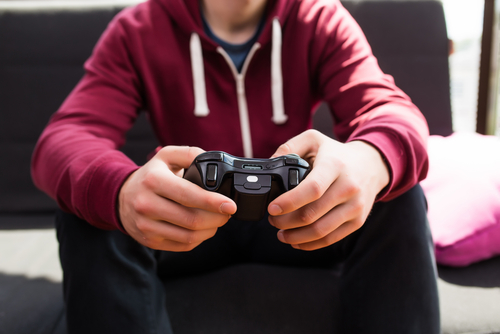Video Games and Addiction: Should Parents Worry About Fortnite?

Sixty-three percent of all households have one gamer living under their roof, according to the 2017 Essential Facts about the Computer and Gaming Industry report released by the Entertainment Software Association (ESA). Computer and video games are a popular way for people of many ages to spend their time. There are different styles of games — from controversial games modeled after combat to family-friendly puzzle games — that appeal to different audiences, but every so often one game ticks the boxes for hundreds of thousands of gamers and becomes a runaway success across gaming markets.
What is Fortnite?
One such cultural phenomenon, a game called Fortnite, has taken millions of players — most of them teens — by storm since its release at the end of 2017. Fortnite is an online video game that can be easily downloaded on a variety of platforms, including smartphones, laptops and gaming consoles. In its original Save the World mode, its objective is to survive zombie-like creatures and defend moving objects with fortifications built during their gaming experience. Players form teams of four, working together for survival. After the success of the Save the World game mode, Fortnite's parent company Epic Games produced another style of Fortnite called Battle Royale, which is a free-to-play version that pits one hundred players against each other as individuals or teams who must fend for themselves with a no-holds-barred instinct to be the last player standing. The game also takes advantage of popular internet memes, using clips from recognizable movies or viral videos and creating movements and dances for players' avatars. Adolescents everywhere can be seen doing the dances that their avatars perform such as The Floss and Best Mates. With the detailed graphics, the camaraderie of other online gamers, and the ease of the game, both Fortnite modes of play have continued to gain notoriety in their success providing an engaging experience for consumers. Epic Games, as of September of 2018, has registered over 125 million players into their Fortnite multimillion-dollar gaming enterprise. With such intense popularity, there is an increasing worry that players are spending endless hours immersed in the game without considering the potential risks of nonstop video gaming. But Fortnite's cultural popularity has weakened the reality that gaming addiction is harmful, real and defined as a mental health disorder — the lighthearted aspects of the game (silly dances or team successes) have started popping up on YouTube videos and gifs, continuing to promote Fortnite as a fun activity with friends rather than a potentially addictive game.Fortnite and Gaming Addiction
In reality, addictions to Fortnite have become increasingly more common over the last year. The news is increasingly covering stories of children failing at school, teens neglecting real-life friendships and adult players ending relationships and marriages because the game has consumed their life. What seems to make Fortnite so addicting is that the game's problem-solving tactics elicit a skill set that humans like to achieve. Solving the game's challenges with teamwork, resourcefulness, and creativity makes players feel clever and accomplished. The reward and pleasure pathways in the brain are triggered; playing games like Fortnite induces production of the neurotransmitter dopamine and gives players a sense of purpose as they participate in the missions and tasks alongside online gamers. These aspects of the game create the obsession of playing the game over and over again to gain the pleasure the player seeks without regard to what they should really be doing — socializing with friends and family, completing their school work, or doing chores around the house. Does this mean that you should be concerned about allowing your son or daughter to play Fortnite? Not necessarily, although as a parent, you should be informed about what Fortnite, in particular, has revealed about gaming addiction. Gaming addiction is not solely limited to Fortnite, but gaming addiction rates among young people are skyrocketing with the introduction of Fortnite. In fact, the Epic Games product was at the forefront of the decision for the WHO to introduce a gaming disorder as a real condition. According to the World Health Organization, a gaming disorder is classified in the ICD-11 as a pattern of gaming behavior characterized by:- Impaired control over gaming (compulsive gaming)
- Prioritizing gaming over other activities to the extent that gaming takes precedence over other interests and daily responsibilities
- Continuation or escalation of gaming despite negative consequences

.jpg)

